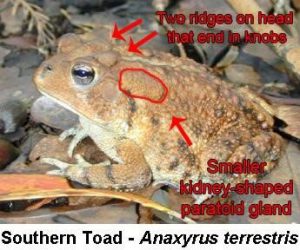This week in the Plant Clinic, Master Gardener Dianne Anstine answers a question about Bufo Toads. You can read more articles by Dianne [here].
Are Deadly Bufo Toads Found in Seminole County?
It’s that time of the year, the rains start and the local newspapers are warning “Florida pet owners wary of deadly toads”. A local dog club was warning members about lethal toad sightings. We often get questions about bugs and wildlife that are found around the gardens and landscapes of Seminole County. We are always happy to help identify any critters and tell you something about them. So, are deadly Bufo toads (Rhinella marina) found in Seminole County?
Wait! What are Bufo Toads?
Dog owners in South Florida are very familiar with Bufo toads. The adult toads are very large; greater than 4 inches, and are attracted to human modified areas such as gardens, landscapes and golf courses. They are ground dwelling, breed prolifically during the rainy season, and are potentially lethal to pets who may find them in the yard. Curious dogs and cats may lick or pick up a Bufo toad. The toad will release it’s toxic venom from very large poison glands located on its shoulders.
Bufo toads are most active during early morning hours and as the sun is setting in the evening. Symptoms will appear in the pet within a very short period of time and treatment should be sought immediately as venom is lethal to pets and wildlife. Pet owners living or visiting South Florida are routinely advised of the symptoms and treatment for Toad Venom Toxicosis with articles such as [this] from Dr. Karen Becker.
As potentially deadly as Bufo toads are known to be to dogs, Seminole County pet owners want to know; are Bufo toads found in my neighborhood? The cane toad (Rhinella marina), sometimes referred to as the “bufo,” giant, or marine toad, is native to extreme southern Texas through Central and tropical South America, but is established in parts of Florida. Figure 1. Shows the current known Bufo / cane toad distribution. As Figure 1 shows, the current answer is, “Not yet!”.

What Should I Do If I Find Bufo Toads in Seminole County?
We consulted Dr. Steve A. Johnson, Associate Professor, Undergraduate Program Coordinator Dept. of Wildlife Ecology & Conservation, University of Florida. Dr Johnson is not aware of Bufo toads in Seminole county but he tells us that they are expanding their range and it is possible the Bufo toads will reach Seminole County.
First, Make Sure They Are Bufo Toads!
If you have found a suspicious toad, you should first determine if you have a Bufo toad or one of our local native toads. The Southern Toad is a common native toad that is frequently mistaken for a Bufo toad. [This] article from Florida Wildlife shows a few ways to tell the two toads apart.

Native toads are useful around the garden; Southern toads will eat small invertebrates including beetles, earwigs, ants, cockroaches, mole crickets, and snails, but are also known to eat anything they can swallow. Our pets, especially dogs are curious about the toad critter hopping around their yard and will frequently lick them and have a short irritation. Many toads, including Southern toads will secrete a material that is an irritant, but is not toxic.

The Bufo toad, or Cane toad is thoroughly described in [this] article from University of Florida IFAS Extension. If you think you have a Bufo toad, please take some good digital photos of the toad. Photos that are in focus, well lit, and close up will be ideal for positively identifying the toad. Compare your photos to the references in this article before you accidentally euthanize a native toad! When in doubt, send your local extension agency pictures of your toad for help with ID.
If you find a cane toad outside their current range (Figure 1), please contact Dr. Steve Johnson of the University of Florida at tadpole@ufl.edu. Please include a picture of the toad as well as the county and address where you found it. Once you have reported the observation to Dr. Johnson, please document it at the EDDMapS site as described [here].
Contact the Plant Clinic
The Seminole County Master Gardener Plant Clinic is open Monday – Friday from 9am-Noon and 1pm-4pm. For more information on how to contact a Master Gardener about your gardening questions, visit our website at this [LINK].
 0
0
